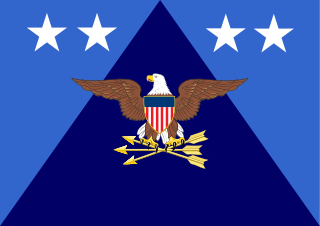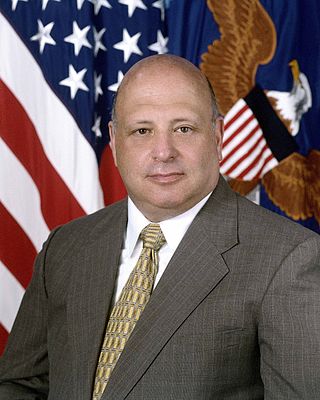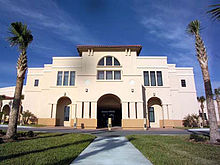
The Army of the Republic of North Macedonia is the military of North Macedonia. The army is organized, prepared and trained to conduct armed struggle and combat and other actions to achieve its constitutional function of defending the independence and territorial integrity of North Macedonia. The army consists of the ground forces and the air force, which are further divided into branches and services. The army has a permanent composition and reserve forces. Since 2005, it is a fully professional defense force compatible with NATO standards. On 27 March 2020, North Macedonia joined NATO as the 30th member.

The United States Secretary of Defense is the head of the United States Department of Defense (DoD), the executive department of the U.S. Armed Forces, and is a high-ranking member of the federal cabinet. The secretary of defense's position of command and authority over the military is second only to that of the president of the United States, who is the commander-in-chief. This position corresponds to what is generally known as a defense minister in many other countries. The president appoints the secretary of defense with the advice and consent of the Senate, and is by custom a member of the Cabinet and by law a member of the National Security Council.

The Joint Chiefs of Staff (JCS) is the body of the most senior uniformed leaders within the United States Department of Defense, which advises the president of the United States, the secretary of defense, the Homeland Security Council and the National Security Council on military matters. The composition of the Joint Chiefs of Staff is defined by statute and consists of a chairman (CJCS), a vice chairman (VJCS), the chiefs of the Army, Marine Corps, Navy, Air Force, Space Force, and the chief of the National Guard Bureau. Each of the individual service chiefs, outside their JCS obligations, works directly under the secretaries of their respective military departments, e.g. the secretary of the Army, the secretary of the Navy, and the secretary of the Air Force.

The Naval War College is the staff college and "Home of Thought" for the United States Navy at Naval Station Newport in Newport, Rhode Island. The NWC educates and develops leaders, supports defining the future Navy and associated roles and missions, supports combat readiness, and strengthens global maritime partnerships.

The Goldwater–Nichols Department of Defense Reorganization Act of October 4, 1986 made the most sweeping changes to the United States Department of Defense since the department was established in the National Security Act of 1947 by reworking the command structure of the U.S. military. It increased the powers of the chairman of the Joint Chiefs of Staff and implemented some of the suggestions from the Packard Commission, commissioned by President Reagan in 1985. Among other changes, Goldwater–Nichols streamlined the military chain of command, which now runs from the president through the secretary of defense directly to combatant commanders, bypassing the service chiefs. The service chiefs were assigned to an advisory role to the president and the secretary of defense, and given the responsibility for training and equipping personnel for the unified combatant commands.

The U.S. Army Medical Command (MEDCOM) is a direct reporting unit of the U.S. Army that formerly provided command and control of the Army's fixed-facility medical, dental, and veterinary treatment facilities, providing preventive care, medical research and development and training institutions. On 1 October 2019, operational and administrative control of all military medical facilities transitioned to the Defense Health Agency.

The United States Strategic Command (USSTRATCOM) is one of the eleven unified combatant commands in the United States Department of Defense. Headquartered at Offutt Air Force Base, Nebraska, USSTRATCOM is responsible for strategic nuclear deterrence, global strike, and operating the Defense Department's Global Information Grid. It also provides a host of capabilities to support the other combatant commands, including integrated missile defense; and global command, control, communications, computers, intelligence, surveillance, and reconnaissance (C4ISR). This command exists to give "national leadership a unified resource for greater understanding of specific threats around the world and the means to respond to those threats rapidly".

The Military Staff of the European Union (EUMS) is the directorate-general of the European Union's (EU) External Action Service (EEAS) that contributes to the EU's Common Security and Defence Policy (CSDP) by providing strategic advice to the High Representative (HR/VP) and commanding operations through its Military Planning and Conduct Capability (MPCC) operational headquarters. From the end of 2020, the MPCC will be capable of running executive operations of up to 2,500 troops, i.e. the size of one EU battle group, as well as 3 non-executive missions.

Lucius Theus was an American military officer and aviator. A Tuskegee Airman during World War II, he became the third black Major General in the United States Air Force.

The under secretary of defense for personnel and readiness, or USD (P&R) is a high-ranking civilian position in the Office of the Secretary of Defense (OSD) within the United States Department of Defense responsible for advising the secretary and deputy secretary of defense on recruitment, career development, pay and benefits, and oversight of the state of military readiness. The under secretary is appointed from civilian life by the president and confirmed by the Senate to serve at the pleasure of the President.

The Marine Corps Systems Command (MCSC) is the acquisition command of the United States Marine Corps, made up of Marines, sailors, civilians and contractors. As the only systems command in the Marine Corps, MCSC serves as Head of Contracting Authority and exercises technical authority for all Marine Corps ground weapon and information technology programs. MCSC is headquartered at Marine Corps Base Quantico.

Located at Kirtland Air Force Base, New Mexico, the Air Force Operational Test and Evaluation Center is a direct reporting unit of Headquarters, United States Air Force. It is the Air Force independent test agency responsible for testing, under operationally realistic conditions, new systems being developed for Air Force and multi-service use.

The Ministry of Defence of Ukraine is the ministry of the Ukrainian government that oversees national defence and the Armed Forces of Ukraine. The head of the ministry is the Minister of Defence. The President of Ukraine is the Supreme Commander-in-Chief of the Armed Forces of Ukraine.
The military modernization program of the People's Liberation Army (PLA) which began in the late 1970s had three major focuses. First, under the political leadership of 3rd paramount leader Deng Xiaoping, the military became disengaged from civilian politics and, for the most part, resumed the political quiescence that characterized its pre-Cultural Revolution role. Deng reestablished civilian control over the military by appointing his supporters to key military leadership positions, by reducing the scope of the PLA's domestic non-military role, and by revitalizing the party political structure and ideological control system within the PLA.

Kathlene Contres, is a former United States Navy captain who was the ranking female Hispanic American line officer on active duty. She was the Commandant of the Defense Equal Opportunity Management Institute (DEOMI), the first Latina woman and the thirteenth Commandant to lead the institute since it was established in 1971. Contres retired from the United States Navy on June 4, 2010, after 30 years of service. Contres also completed two terms as the president of the Association of Naval Services Officers (ANSO).

The Maritime Civil Affairs and Security Training Command (MCAST) provides personnel, trains, equips and deploys U.S. Navy sailors for a task force commander to establish and enhance relations between military forces, governmental and nongovernmental organizations and the civilian populace. Accomplished in a collaborative manner across the spectrum of operations in the maritime environment, MCAST Command executes civilian-to-military operations and military-to-military training, as directed, in support of security cooperation and security assistance requirements.

Bernard Daniel Rostker was Principal Deputy Assistant Secretary of the Navy from 1977 to 1979; 5th Director of the Selective Service System from 1979 to 1981; Assistant Secretary of the Navy from 1994 to 1998; Under Secretary of the Army from 1998 to 2000; and Under Secretary of Defense for Personnel and Readiness in 2000–2001. From 1996 to 2001, he also served as Special Assistant to the Deputy Secretary of Defense for Gulf War Illnesses.

The Assistant Secretary of Defense for Readiness and Force Management, or ASD(R&FM), is a Defense Department position responsible for civilian and military personnel policy, readiness of the force, military community and family policy and diversity management and equal opportunity.

The Republic of China Armed Forces Reserve is a division of the Republic of China Armed Forces tasked with managing, planning, and mobilizing the reserve potential of Taiwan. It aimed to provide the first line of coastal defence and wartime operations through its reserve forces, and to sustain military mobilization to support ground operations, maintenance, and homeland security. Another major role of the Reserve Command was the recruitment, education, and training of effective reserve forces. In 2022, it was assigned to the All-Out Defense Mobilization Agency.




















